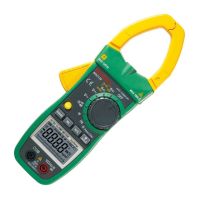25 2 6
1) Do not put more than one cable into the jaw during
test, otherwise incorrect test value might be obtained.
2) If the duty cycle is less than 10%, symbol 'UL' will be
displayed on LCD; if the duty cycle is more than
94.9%, symbol 'OL' will be displayed on LCD.
3) The input signal frequency range is 10-1kHz. It is
possible to test duty cycle of the higher than 1 kHz
frequency signal, but the tolerance of the test result
can not be ensure.
4) “ ” means the maximum input current is 1000A
rms AC.
NOTE:
4.14.2 By V range:
Beware of Electrocution.
Pay special attention to avoid electric shock
when measuring high voltage.
Do not input the voltage which more than 600V
rms AC.
WARNING
4.14.2.1 Plug the black test lead into the COM jack
and the red test lead into the INPUT jack.
4.14.2.2 Set the rotary selector to the range position.
4.14.2.3 Press the "Hz/%" to switch to DUTY
measurement.
4.14.2.4 Connect test leads to the two end of the source
or load for measurement.
4.14.2.5 Take the reading on the LCD.
NOTE:
1) If the duty cycle is less than 10%, symbol 'UL' will be
displayed on LCD; if the duty cycle is more than
94.9%, symbol 'OL' will be displayed on LCD.
3) The input signal frequency range is 10 -10 kHz. It is
possible to test duty cycle of the higher than 10 kHz
frequency signal, but the tolerance of the test result
can not be ensure.
3) “ ”means the maximum input voltage is 600V rms AC.
4.14.3 By HZ/DUTY range:
Beware of Electrocution. Pay special attention
to avoid electric shock when measuring high
voltage. Do not input the voltage which more
than 250V rms AC.
WARNING
4.14.3.1 Plug the black test lead into the COM jack and
the red test lead into the INPUT jack.
4.14.2.2 Set the rotary selector to the HZ/DUTY range
position.
4.14.2.3 Press the "Hz/%" to switch to DUTY
measurement.
4.14.2.4 Connect test leads to the two end of the source
or load for measurement.
4.14.2.5 Take the reading on the LCD.
V

